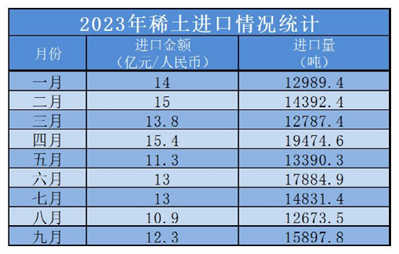
Rare earth import and export data released in September 2023
2023-10-23 13:52On October 13, the General Administration of Customs announced import and export data for September. In September, exports of rare earth products decreased while imports increased. Details are as follows:
In September, 3,935.2 tons of rare earth commodities were exported, a month-on-month decrease of 17.6%, and the export value reached 380 million yuan, a month-on-month decrease of 17.4%.
In 2023, the cumulative export of rare earth commodities was 40,371.8 tons, a year-on-year increase of 6.6%, and the cumulative export value reached 4.35 billion yuan, a year-on-year decrease of 18.7%.

In September, 15,897.8 tons of rare earth products were imported, a month-on-month increase of 25.4%, and the import value reached 1.23 billion yuan, a month-on-month increase of 12.8%.
In 2023, a total of 134,333.8 tons of rare earth products will be imported, a year-on-year increase of 49.2%, and the cumulative import value will reach 11.84 billion yuan, a year-on-year increase of 58.7%.

Q1. What are rare earth products and why are they important for exports?
A1. Rare earth products are a group of 17 chemical elements that are essential in the production of a wide range of high-tech products, including smartphones, electric vehicles, wind turbines, and defense systems. They are important for exports because they are in high demand worldwide and are critical for many industries.
Q2. Which countries are the largest exporters of rare earth products?
A2. According to recent data, China is the largest exporter of rare earth products, accounting for over 80% of global exports. Other significant exporters include Australia, the United States, Myanmar, and Russia.
Q3. How has the global demand for rare earth products changed over time?
A3. The global demand for rare earth products has increased significantly over the past few decades, driven primarily by the growth of high-tech industries such as electronics, renewable energy, and electric vehicles. According to a report by Grand View Research, the global rare earth metals market size was valued at USD 4.6 billion in 2019 and is expected to grow at a compound annual growth rate (CAGR) of 10.4% from 2020 to 2027. This growth is attributed to the increasing demand for rare earth metals in various applications such as magnets, catalysts, metallurgy, and polishing. Additionally, the growing demand for clean energy technologies such as wind turbines and electric vehicles is expected to further boost the demand for rare earth products in the coming years.
Q4. What impact do export restrictions on rare earth products have on international trade?
A4. Export restrictions on rare earth products can have significant impacts on international trade. Rare earth elements are essential components in many modern technologies, including electronics, renewable energy, and defense systems. Countries that rely on these technologies may face supply chain disruptions and increased costs if they cannot access the rare earth elements they need. Additionally, export restrictions may lead to trade disputes and tensions between countries. However, some argue that export restrictions can also incentivize domestic production and reduce environmental damage caused by rare earth mining. Overall, the impact of export restrictions on rare earth products on international trade is complex and multifaceted.
Q5. What are 8 common products that use rare earth metals?
A5. Rare-earth elements (REEs) are used as components in high technology devices, including smart phones, digital cameras, computer hard disks, fluorescent and light-emitting-diode (LED) lights, flat screen televisions, computer monitors, and electronic displays.
